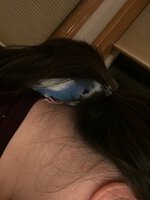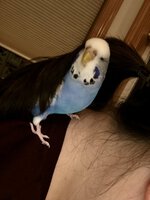EnglishBudgMom
Walking the driveway
Sooo... Bubbles (1.5 yr old English Budgie) has come into her first season. Her cere is a darker, crusty brown now. I've noticed her poops have gotten bigger and slightly more watery, and lately she's been doing stuff she hasn't done since she was a baby. She used to love snuggling under things, my shirt, a blanket, and especially under my ponytail (I use a hair clip rather than a scrunchie). The last two days when she's been sitting on me for a bit, she'll crawl under there and preen/nibble gently on my neck hairs and the clip. I reached back once and put my hand over the clip area, to feel hair and Bird.... and a nip on my finger  she did not want me messing with her in the "hair hideout". She's bigger now, but mostly fits under my hair, I guess.
she did not want me messing with her in the "hair hideout". She's bigger now, but mostly fits under my hair, I guess.


My concern is that this is "nesty" behavior??? I just find it weird she's gone back to this habit after so long, and developing into a no-touchy bird. She is tame, steps up, etc... but does not like being touched. She hasn't asked for head scratches since I last took her to the vet for a nail trim and she let me scritch her in the car... who knew? My parents were just visiting and my Mom wants to "pet her soft soft head" (that's what she said) and Bubbles will not have any of that business. Your thoughts?
 she did not want me messing with her in the "hair hideout". She's bigger now, but mostly fits under my hair, I guess.
she did not want me messing with her in the "hair hideout". She's bigger now, but mostly fits under my hair, I guess.


My concern is that this is "nesty" behavior??? I just find it weird she's gone back to this habit after so long, and developing into a no-touchy bird. She is tame, steps up, etc... but does not like being touched. She hasn't asked for head scratches since I last took her to the vet for a nail trim and she let me scritch her in the car... who knew? My parents were just visiting and my Mom wants to "pet her soft soft head" (that's what she said) and Bubbles will not have any of that business. Your thoughts?

